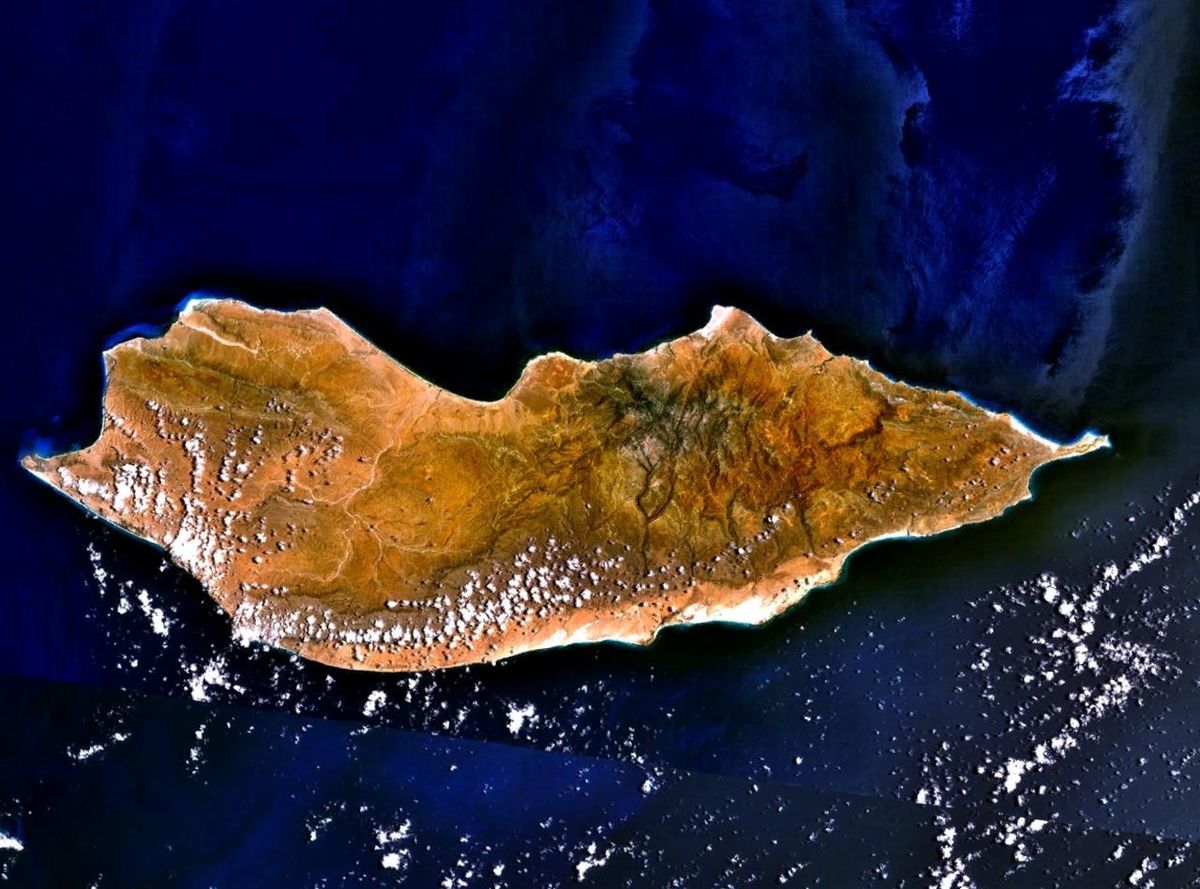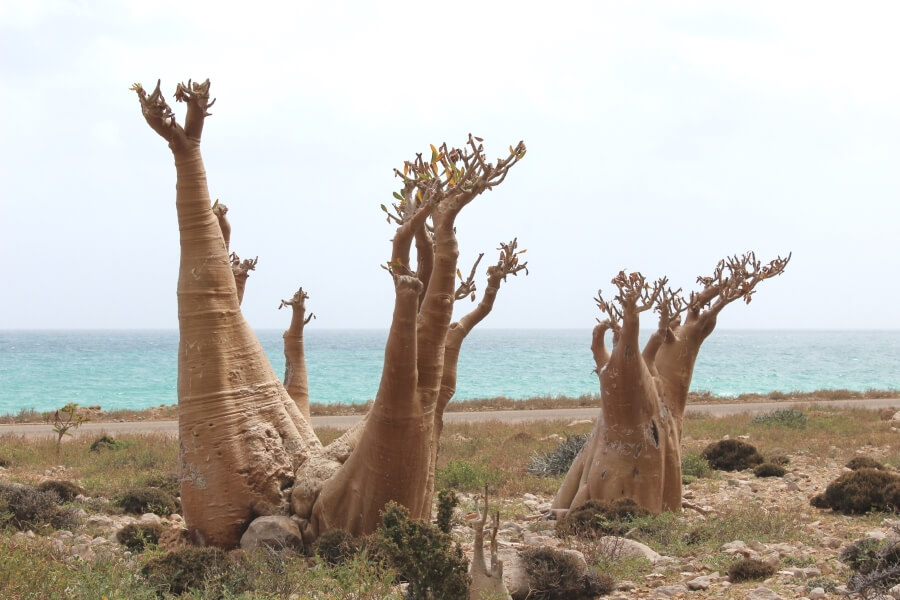Estimated reading time: 8 minutes

What is Socotra Island?
Socotra, or Soqotra, is an archipelago in the Indian Ocean right off the Horn of Africa. 95% of the landmass consists of the main island, named Socotra Island. It is under the control of the Southern Transitional Council, an organisation fighting in Yemen’s ongoing civil war. Many people who travel here describe it as the most alien place on Planet Earth—after you visit, you’ll see why. Seven hundred endemic species call this island home. From the Dragon’s Blood Tree to the Blue Baboon Spider, Socotra contains plants and animals found nowhere else. The name derives from the Sanskrit phrase “Dvīpa Sukhadara,” meaning “island of bliss.” With less than 1,000 tourists a year, friendly inhabitants, and a host of sights, sounds, smells, and experiences, it has truly earned that name.

The famous Dragon’s Blood Tree
Why Should You Travel There?
Simply put: There is no nowhere else like it.
Ayhaft Canyon National Park has freshwater pools perfect for swimming, desert roses blossoming in the warm sun, and native birds fluttering around. The Dixam Plateau is peppered with the mighty Dragon’s Blood Tree and offers a beautiful valley view. Dihammri, containing perhaps the most pristine coral reefs in the Indian Ocean, is teeming with aquatic species. Hoq Cave holds ancient archaeological findings such as pottery and a wide variety of stalactites and stalagmites. In Defarhu Valley, giant dunes nestle against mountains.
And to think, all this beauty lives on an island that is only 132 kilometres long and 50 kilometres wide!



History of Socotra
The history of this archipelago is still little known.
Ancient Socotrans never had a written language. All information about Socotra’s past comes from reports by various explorers and archaeological remains. Details of this destination are as mysterious as the island itself.
Though, there are some things experts have discovered about Socotra:
- 1.4 Million Years Ago: Homo Erectus people came to Socotra. In 2008, a Russian archaeological expedition discovered thousands of Oldowan tools, indicating that people migrated here during the Stone Age.
- 1st Century BC to 6th Century BC: Sailors visit the island en route to various destinations on the Indian Ocean trade network.
- 52 AD: Thomas the Apostle visits Socotra, converting all the inhabitants to Christianity.
- 1507: A Portuguese fleet lands in Socotra and establishes a base for stops en route to India.
- 1511: The Mahra Sultanate takes control of the island, converting the inhabitants to Islam. They rule for several hundred years.
- 1876: Socotra becomes a protectorate of the British Empire but is still ruled by the Mahra.
- 1967: The British depart. In its wake, the Mahra Sultanate was abolished, and Socotra became a part of South Yemen.
- 1990: South Yemen and North Yemen unite to form the Republic of Yemen. Socotra becomes part of this new republic.
- 2014: Civil war breaks out on the mainland of Yemen, but Socotra remains largely unaffected.
- 2017: The Southern Transitional Council, backed by the United Arab Emirates, claims to rule over five southern governates in Yemen, including Socotra.
- 2018: The United Arab Emirates lands troops on the island, seizing control of the airport and seaports.
People of Socotra
Only about 50,000 people live on the island. The majority of the population is from the indigenous Al-Mahrah tribe. In addition to Socotra, people from this tribe live in the Al Mahrah Governorate of Yemen and the Dhofar Governorate of Oman.

The capital is Hadibu, with a population of only 8,545. Such a small number of inhabitants makes even the biggest city feels like a quaint, remote village!
The lifestyle of this small island is very laid back. People primarily fish, raise livestock, and grow dates and pomegranates to make a living.
People from Socotra speak the Afroasiatic language, Soqotri. It is one of six languages in the Modern South Arabian languages family. The other five languages are Mehri, Hobyot, Bathari, Shehri, and Harsusi.

Flora and Fauna of Socotra Island
There is no shortage of strange yet wondrous plants and animals. The crown jewel of Soqotri biodiversity is the rare Dragon’s Blood Tree. Its umbrella-like canopy and long, weaving branches are instantly recognisable.
Some fun facts about the Dragon’s Blood Tree:
- Their resin is dark red and looks like blood.
- Ancient Soqotri people believed the resin was literally the blood of dragons and used it in ceremonial magic rituals and alchemy.
- Ancient Romans used the resin for medicinal purposes; it was first mentioned in the 1st century AD.
- They can live for hundreds of years.
You can also find other interesting plants, such as the cucumber tree Dendrosicyos socotranus, the delicious Socotran pomegranate, and many more.
Birds of different kinds frequently soar above this island of wonder, like the Socotra golden-winged grosbeak, and reptiles like the Socotran chameleon build their homes in the trees.
This is just the tip of the iceberg. To this day, scientists continue to discover new species which call this tiny island home. Given its unique life found nowhere else, UNESCO named the Socotra archipelago a world heritage site in 2008.








How Do You Get There?
It depends.
The options for getting to Socotra change regularly. Currently, there are indirect flights from Cairo via Aden. Email us for the latest information and assistance with booking flights.
Do You Need Vaccinations?
You don’t need any vaccinations to get into Socotra, though it is recommended to get a malaria vaccine.
You should speak with a health care professional at least eight weeks before departure. They can advise you on what steps you should take to protect your health while travelling to Socotra.
Is Socotra Safe?
Of course.
We routinely work with risk consultants and local advisors to assess the security situation on the ground in each of our tours. Socotra remains a safe destination for tourists, as it is still unaffected in any serious way by the ongoing conflict in Yemen.
Are you interested in travelling to Socotra? Check out the tour page for more information.
Questions? Comments? Concerns? Call or email us.
Keep In touch
Make sure you never miss an adventure by signing up to our mailing list. Be the first to know about new tours and travel tips.
